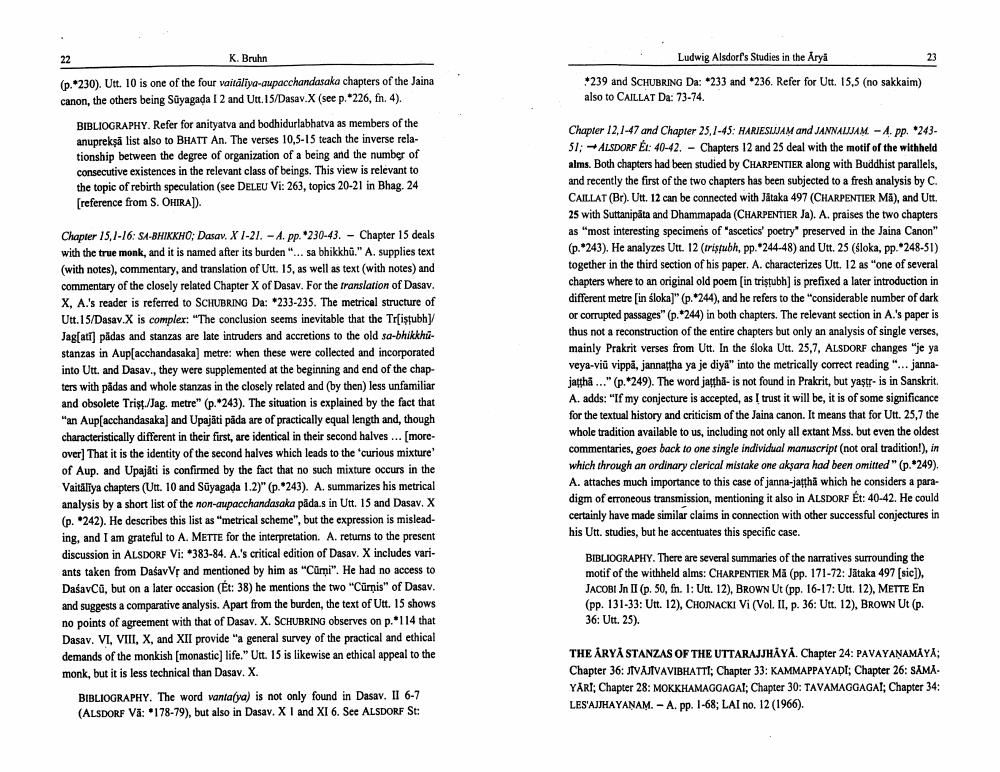Book Title: Ludwig Alsdorfs Studies In Arya Author(s): Klaus Bruhn Publisher: Klaus Bruhn View full book textPage 9
________________ K. Bruhn 22 (p. 230). Utt. 10 is one of the four vaitaliya-aupacchandasaka chapters of the Jaina canon, the others being Süyagada I 2 and Utt. 15/Dasav.X (see p. 226, fin. 4). BIBLIOGRAPHY. Refer for anityatva and bodhidurlabhatva as members of the anupreksă list also to BHATT An. The verses 10,5-15 teach the inverse relationship between the degree of organization of a being and the number of consecutive existences in the relevant class of beings. This view is relevant to the topic of rebirth speculation (see DELEU VI: 263, topics 20-21 in Bhag. 24 [reference from S. OHIRA]). Chapter 15,1-16: SA-BHIKKHO; Dasav. X 1-21.-A. pp. 230-43. Chapter 15 deals with the true monk, and it is named after its burden "... sa bhikkhu." A. supplies text (with notes), commentary, and translation of Utt. 15, as well as text (with notes) and commentary of the closely related Chapter X of Dasav. For the translation of Dasav. X, A.'s reader is referred to SCHUBRING Da: *233-235. The metrical structure of Utt.15/Dasav.X is complex: "The conclusion seems inevitable that the Tr[istubh]/ Jag[at] pādas and stanzas are late intruders and accretions to the old sa-bhikkhustanzas in Aup[acchandasaka] metre: when these were collected and incorporated into Utt. and Dasav., they were supplemented at the beginning and end of the chapters with pādas and whole stanzas in the closely related and (by then) less unfamiliar and obsolete Trist./Jag. metre" (p. 243). The situation is explained by the fact that "an Aup[acchandasaka] and Upajāti pāda are of practically equal length and, though characteristically different in their first, are identical in their second halves... [more. over] That it is the identity of the second halves which leads to the 'curious mixture' of Aup. and Upajäti is confirmed by the fact that no such mixture occurs in the Vaitaliya chapters (Utt. 10 and Süyagada 1.2)" (p. 243). A. summarizes his metrical analysis by a short list of the non-aupacchandasaka päda.s in Utt. 15 and Dasav. X (p. 242). He describes this list as "metrical scheme", but the expression is misleading, and I am grateful to A. METTE for the interpretation. A. returns to the present discussion in ALSDORF Vi: *383-84. A.'s critical edition of Dasav. X includes variants taken from DasavVr and mentioned by him as "Cümi". He had no access to Dasavcũ, but on a later occasion (Ét: 38) he mentions the two "Cürnis" of Dasav. and suggests a comparative analysis. Apart from the burden, the text of Utt. 15 shows no points of agreement with that of Dasav. X. SCHUBRING observes on p. 114 that Dasav. VI, VIII, X, and XII provide "a general survey of the practical and ethical demands of the monkish [monastic] life." Utt. 15 is likewise an ethical appeal to the monk, but it is less technical than Dasav. X. BIBLIOGRAPHY. The word vanta(ya) is not only found in Dasav. II 6-7 (ALSDORF Vä: 178-79), but also in Dasav. X I and XI 6. See ALSDORF St: Ludwig Alsdorf's Studies in the Arya *239 and SCHUBRING Da: 233 and $236. Refer for Utt. 15,5 (no sakkaim) also to CAILLAT Da: 73-74. 23 Chapter 12,1-47 and Chapter 25,1-45: HARIESIJJAM and JANNALIJAM - A. pp. 24351;ALSDORF Ét: 40-42. Chapters 12 and 25 deal with the motif of the withheld alms. Both chapters had been studied by CHARPENTIER along with Buddhist parallels, and recently the first of the two chapters has been subjected to a fresh analysis by C. CAILLAT (Br). Utt. 12 can be connected with Jätaka 497 (CHARPENTIER Mā), and Utt. 25 with Suttanipata and Dhammapada (CHARPENTIER Ja). A. praises the two chapters as "most interesting specimens of "ascetics' poetry" preserved in the Jaina Canon" (p.*243). He analyzes Utt. 12 (tristubh, pp. 244-48) and Utt. 25 (sloka, pp. 248-51) together in the third section of his paper. A. characterizes Utt. 12 as "one of several chapters where to an original old poem [in tristubh] is prefixed a later introduction in different metre [in sloka]" (p. *244), and he refers to the "considerable number of dark or corrupted passages" (p.*244) in both chapters. The relevant section in A.'s paper is thus not a reconstruction of the entire chapters but only an analysis of single verses, mainly Prakrit verses from Utt. In the sloka Utt. 25,7, ALSDORF changes "je ya veya-viü vippä, jannattha ya je diyä" into the metrically correct reading "... jannajattha..." (p. 249). The word jatthä- is not found in Prakrit, but yaştr- is in Sanskrit. A. adds: "If my conjecture is accepted, as I trust it will be, it is of some significance for the textual history and criticism of the Jaina canon. It means that for Utt. 25,7 the whole tradition available to us, including not only all extant Mss. but even the oldest commentaries, goes back to one single individual manuscript (not oral tradition!), in which through an ordinary clerical mistake one aksara had been omitted" (p. 249). A. attaches much importance to this case of janna-jattha which he considers a paradigm of erroneous transmission, mentioning it also in ALSDORF Ét: 40-42. He could certainly have made similar claims in connection with other successful conjectures in his Utt. studies, but he accentuates this specific case. BIBLIOGRAPHY. There are several summaries of the narratives surrounding the motif of the withheld alms: CHARPENTIER Mã (pp. 171-72: Jātaka 497 [sic]), JACOBI Jn II (p. 50, fn. 1: Utt. 12), BROWN Ut (pp. 16-17: Utt. 12), METTE En (pp. 131-33: Utt. 12), CHOJNACKI Vi (Vol. II, p. 36: Utt. 12), BROWN Ut (p. 36: Utt. 25). THE ARYA STANZAS OF THE UTTARAJJHAYA. Chapter 24: PAVAYANAMĀYĀ; Chapter 36: JIVĀJĪVAVIBHATTI; Chapter 33: KAMMAPPAYADI; Chapter 26: SAMAYARI; Chapter 28: MOKKHAMAGGAGAI; Chapter 30: TAVAMAGGAGAI; Chapter 34: LES'AJJHAYANAM.-A. pp. 1-68; LAI no. 12 (1966).Page Navigation
1 ... 7 8 9 10 11 12 13 14 15 16 17 18 19 20 21 22 23 24 25
